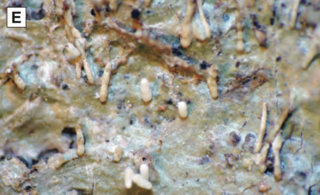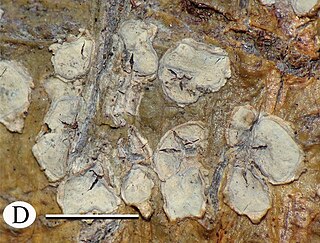Acantholichen is a fungal genus in the family Hygrophoraceae. The genus was circumscribed by Norwegian lichenologist Per Magnus Jørgensen to contain the type, and at that time, only species, the basidiolichen Acantholichen pannarioides, discovered originally in Costa Rica in 1998. This species has a bluish, gelatinous thallus, and a fine, white powdery bloom covering the hairy upper surface; this surface is said to resemble "an unshaven chin". Five additional species, all basidiolichens, were added to the genus in 2016 following an in-depth analysis of specimens collected from the Galápagos, Costa Rica, Brazil and Colombia.
Carbacanthographis is a genus of corticolous (bark-dwelling) lichens in the family Graphidaceae. The genus was circumscribed by German lichenologists Bettina Staiger and Klaus Kalb in 2002. An updated worldwide key to the genus was published in 2022 that added 17 new species. This revision allowed for further identification of undescribed species from other collections, and subsequently, 14 species were added in 2023 from the Amazonian lowland forests of Brazil and the Guianas.

Acanthothecis is a genus of lichen-forming fungi in the family Graphidaceae. The genus was circumscribed by Frederick Edward Clements in 1909.

Myriotrema is a genus of lichen-forming fungi in the family Graphidaceae.
Melanotrema is a genus of lichen-forming fungi in the family Graphidaceae. The genus was circumscribed by German lichenologist Andreas Frisch in 2006, with M. platystomum assigned as the type species.
Leucodecton is a genus of lichen-forming fungi in the family Graphidaceae. The genus was circumscribed in 1860 by Swiss lichenologist Abramo Bartolommeo Massalongo, with Leucodecton compunctum assigned as the type species.
Chapsa is a genus of lichens in the family Graphidaceae. The genus was circumscribed by Italian lichenologist Abramo Bartolommeo Massalongo in 1860.

Acanthotrema is a genus of lichens in the family Graphidaceae. The genus was circumscribed by German lichenologist Andreas Frisch in 2006, with Acanthotrema brasilianum assigned as the type species. Acanthotrema species are commonly found in rainforests ranging from lowland to montane environments.

The Trypetheliaceae are a family of mainly lichen-forming fungi in the order Trypetheliales. The family consists almost exclusively of corticolous (bark-dwelling), crustose lichens with an almost strictly tropical distribution.
Calenia is a genus of lichen-forming fungi within the family Gomphillaceae.
Aptrootia is a genus of fungi in the family Trypetheliaceae. It has three species. The genus was circumscribed by Robert Lücking and Harrie Sipman in 2007, with Aptrootia terricola assigned as the type species. This species, originally described by Dutch mycologist André Aptroot as a species of Thelenella, is known from Papua New Guinea and Costa Rica. Later molecular work showed that the species did not belong in Thelenella, but rather, in the Trypetheliaceae, with a sister taxon relationship to a branch including Bathelium and a lineage containing Trypethelium floridanum. The new genus name honours Aptroot, "in recognition of his numerous contributions to tropical lichenology".

Astrothelium is a large genus of corticolous (bark-dwelling) lichens in the family Trypetheliaceae. The genus is characterized by a corticate thallus and diverse ascomata structures, which can be simple, aggregated, or forming pseudostromata. Astrothelium is also notable for the carbonized walls of its ascomata, the so-called textura intricata arrangement of cells in these walls, and various forms of distoseptate, transparent spores.
André Aptroot is a Dutch mycologist and lichenologist. His primary research focus is on biodiversity, particularly tropical lichens, encompassing systematics, floristic surveys, and taxonomic reviews. A prolific researcher, he has published more than 500 scientific papers and described hundreds of new fungal and lichen species.
Ampliotrema is a genus of lichen-forming fungi in the family Graphidaceae. The genus was originally described invalidly in 2004, and validly two years later.

Coenogonium is a genus of filamentous lichens in the monotypic family Coenogoniaceae. It has about 90 species. Most species are leaf-dwelling or grow on bark, although a few are known to grow on rocks under certain conditions, and some are restricted to growth on termite nests. The genus was circumscribed in 1820 by German naturalist Christian Gottfried Ehrenberg.

Astrochapsa is a genus of lichen-forming fungi in the subfamily Graphidoideae of the family Graphidaceae. It has 28 species. The genus was circumscribed by Sittiporn Parnmen, Robert Lücking, and H. Thorsten Lumbsch in 2012, with Astrochapsa astroidea assigned as the type species. It was segregated from the genus Chapsa, from which it differs in having a more frequently densely corticate thallus, an apothecial margin that is mostly recurved, and the almost exclusively subdistoseptate, non-amyloid ascospores.

Megalospora is a genus of lichen-forming fungi in the family Megalosporaceae.
Henricus (Harrie) Johannes Maria Sipman is a retired Dutch lichenologist who specialised in tropical and subtropical lichens and authored or co-authored over 250 scientific publications. He was the curator of the lichen herbarium at the Berlin Botanical Garden and Botanical Museum from 1983 until his retirement in 2010.

Heiomasia is a genus of corticolous (bark-dwelling), crustose lichens in the family Graphidaceae. It has five species.
Myriochapsa is a genus of corticolous (bark-dwelling), crustose lichens in the subfamily Graphidoidae of the family Graphidaceae. It has three species. The genus was circumscribed in 2013 by Marcela Cáceres, Robert Lücking, and H. Thorsten Lumbsch, with the Brazilian Myriochapsa psoromica assigned as the type species. The generic name combines Myriotrema and Chapsa, referring to the two Graphidaceae genera that it resembles. The main distinguishing characteristics of the new genus are its densely corticate thallus, and the presence of the lichen product psoromic acid. Additionally, its apothecia have wider pores, with differently textured margins. Although originally created as a monotypic genus, Harrie Sipman added two South American species in 2014.








